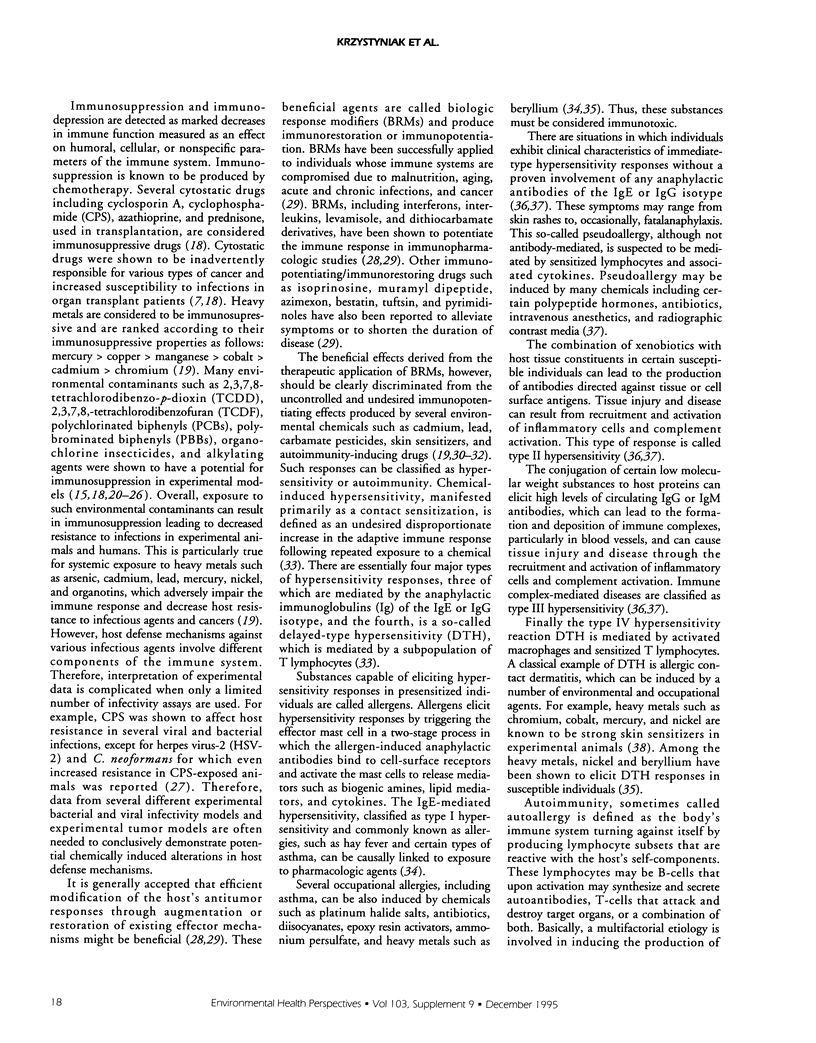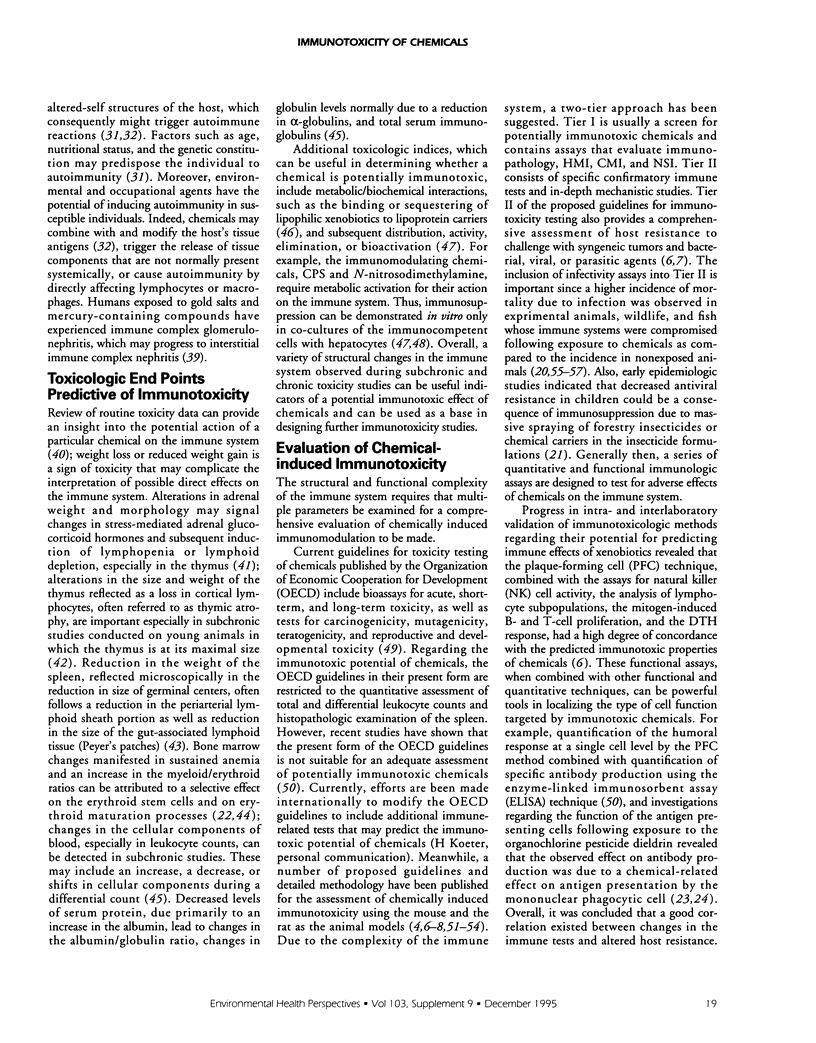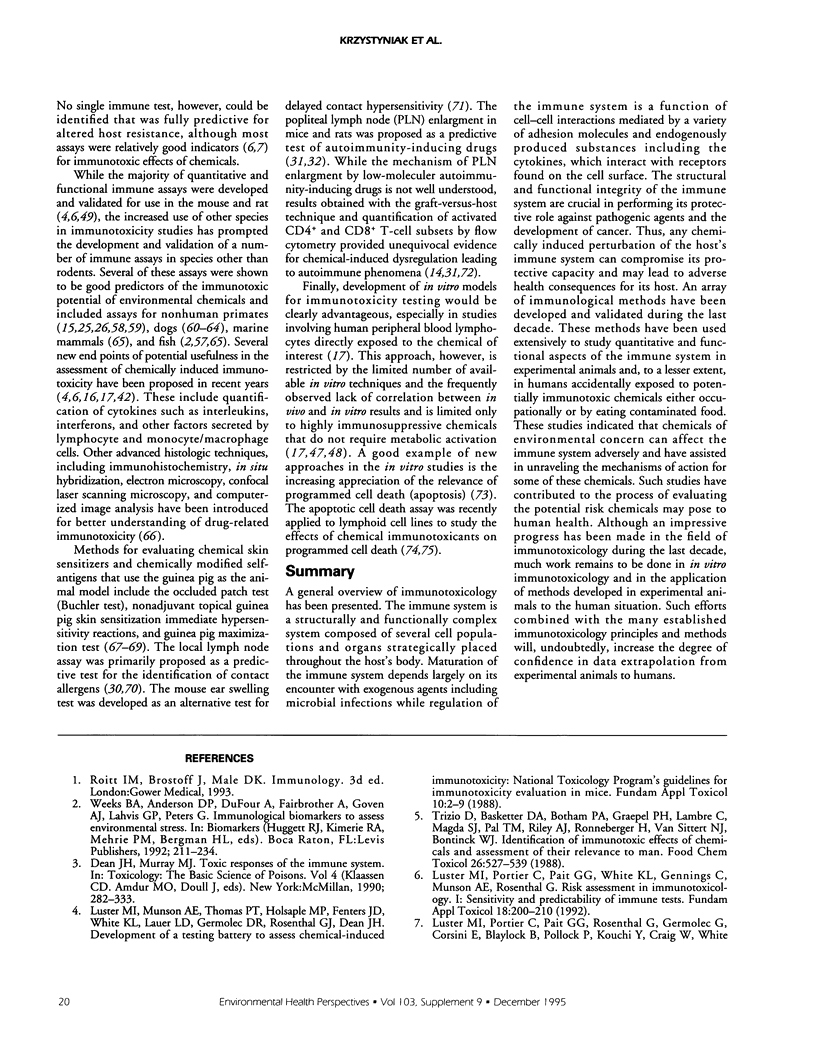Abstract
The immune system plays a crucial role in maintaining health; however, accumulating evidence indicates that this system can be the target for immunotoxic effects caused by a variety of chemicals including the environmental pollutants of polychlorinated biphenyls, chlorinated dibenzo-p-dioxins, pesticides, and heavy metals. Adverse chemical-induced immunomodulation, which is studied within the discipline of immunotoxicology, may be expressed either as immunosuppression/immunodepression or immunoenhancement. The former may be manifested either as decreased resistance to opportunistic viral, bacterial, fungal, and other infectious agents or increased susceptibility to cancer. Immunoenhancement on the other hand may either increase the risk of autoimmune reactions or result in allergic reactions. This paper attempts to integrate several aspects of the immune system that are relevant to the assessment of potentially immunotoxic chemicals.
Full text
PDF





Selected References
These references are in PubMed. This may not be the complete list of references from this article.
- Bradley S. G., Morahan P. S. Approaches to assessing host resistance. Environ Health Perspect. 1982 Feb;43:61–69. doi: 10.1289/ehp.824361. [DOI] [PMC free article] [PubMed] [Google Scholar]
- Burchiel S. W., Davis D. A., Ray S. D., Barton S. L. DMBA induces programmed cell death (apoptosis) in the A20.1 murine B cell lymphoma. Fundam Appl Toxicol. 1993 Jul;21(1):120–124. doi: 10.1006/faat.1993.1080. [DOI] [PubMed] [Google Scholar]
- Corcoran G. B., Fix L., Jones D. P., Moslen M. T., Nicotera P., Oberhammer F. A., Buttyan R. Apoptosis: molecular control point in toxicity. Toxicol Appl Pharmacol. 1994 Oct;128(2):169–181. doi: 10.1006/taap.1994.1195. [DOI] [PubMed] [Google Scholar]
- Crocker J. F., Ozere R. L., Safe S. H., Digout S. C., Rozee K. R., Hutzinger O. Lethal interaction of ubiquitous insecticide carriers with virus. Science. 1976 Jun 25;192(4246):1351–1353. doi: 10.1126/science.179146. [DOI] [PubMed] [Google Scholar]
- Dean J. H., Ward E. C., Murray M. J., Lauer L. D., House R. V., Stillman W., Hamilton T. A., Adams D. O. Immunosuppression following 7,12-dimethylbenz[a]anthracene exposure in B6C3F1 mice--II. Altered cell-mediated immunity and tumor resistance. Int J Immunopharmacol. 1986;8(2):189–198. doi: 10.1016/0192-0561(86)90058-5. [DOI] [PubMed] [Google Scholar]
- Gad S. C. The mouse ear swelling test (MEST) in the 1990s. Toxicology. 1994 Sep 22;93(1):33–46. doi: 10.1016/0300-483x(94)90194-5. [DOI] [PubMed] [Google Scholar]
- Gleichmann E., Kimber I., Purchase I. F. Immunotoxicology: suppressive and stimulatory effects of drugs and environmental chemicals on the immune system. A discussion. Arch Toxicol. 1989;63(4):257–273. doi: 10.1007/BF00278639. [DOI] [PubMed] [Google Scholar]
- Glickman L. T., Shofer F. S., Payton A. J., Laster L. L., Felsburg P. J. Survey of serum IgA, IgG, and IgM concentrations in a large beagle population in which IgA deficiency had been identified. Am J Vet Res. 1988 Aug;49(8):1240–1245. [PubMed] [Google Scholar]
- Hennighausen G., Lange P., Stülpner H., Ambrosius H., Karnstedt U. Uber Wirkungen von Dialkylzinnsalzen auf das Immunsystem. Acta Biol Med Ger. 1980;39(1):149–155. [PubMed] [Google Scholar]
- Hinton D. M. Testing guidelines for evaluation of the immunotoxic potential of direct food additives. Crit Rev Food Sci Nutr. 1992;32(2):173–190. doi: 10.1080/10408399209527594. [DOI] [PubMed] [Google Scholar]
- Kaminski N. E., Wells D. S., Dauterman W. C., Roberts J. F., Guthrie F. E. Macrophage uptake of a lipoprotein-sequestered toxicant: a potential route of immunotoxicity. Toxicol Appl Pharmacol. 1986 Mar 15;82(3):474–480. doi: 10.1016/0041-008x(86)90282-6. [DOI] [PubMed] [Google Scholar]
- Kammüller M. E., Thomas C., De Bakker J. M., Bloksma N., Seinen W. The popliteal lymph node assay in mice to screen for the immune disregulating potential of chemicals--a preliminary study. Int J Immunopharmacol. 1989;11(3):293–300. doi: 10.1016/0192-0561(89)90167-7. [DOI] [PubMed] [Google Scholar]
- Kim D. H., Yang K. H., Johnson K. W., Holsapple M. P. Suppression of in vitro antibody production by dimethylnitrosamine in mixed cultures of mouse primary hepatocytes and mouse splenocytes. Toxicol Appl Pharmacol. 1987 Jan;87(1):32–42. doi: 10.1016/0041-008x(87)90081-0. [DOI] [PubMed] [Google Scholar]
- Kimber I. Aspects of the immune response to contact allergens: opportunities for the development and modification of predictive test methods. Food Chem Toxicol. 1989 Nov;27(11):755–762. doi: 10.1016/0278-6915(89)90081-1. [DOI] [PubMed] [Google Scholar]
- Kimber I., Hilton J., Botham P. A., Basketter D. A., Scholes E. W., Miller K., Robbins M. C., Harrison P. T., Gray T. J., Waite S. J. The murine local lymph node assay: results of an inter-laboratory trial. Toxicol Lett. 1991 Feb;55(2):203–213. doi: 10.1016/0378-4274(91)90135-s. [DOI] [PubMed] [Google Scholar]
- Kleinbeck M. L., Hites M. J., Loker J. L., Halliwell R. E., Lee K. W. Enzyme-linked immunosorbent assay for measurement of allergen-specific IgE antibodies in canine serum. Am J Vet Res. 1989 Nov;50(11):1831–1839. [PubMed] [Google Scholar]
- Krzystyniak K., Brouland J. P., Panaye G., Patriarca C., Verdier F., Descotes J., Revillard J. P. Activation of CD4+ and CD8+ lymphocyte subsets by streptozotocin in murine popliteal lymph node (PLN) test. J Autoimmun. 1992 Apr;5(2):183–197. doi: 10.1016/0896-8411(92)90199-z. [DOI] [PubMed] [Google Scholar]
- Krzystyniak K., Flipo D., Mansour S., Fournier M. Suppression of avidin processing and presentation by mouse macrophages after sublethal exposure to dieldrin. Immunopharmacology. 1989 Nov-Dec;18(3):157–166. doi: 10.1016/0162-3109(89)90013-1. [DOI] [PubMed] [Google Scholar]
- Luster M. I., Munson A. E., Thomas P. T., Holsapple M. P., Fenters J. D., White K. L., Jr, Lauer L. D., Germolec D. R., Rosenthal G. J., Dean J. H. Development of a testing battery to assess chemical-induced immunotoxicity: National Toxicology Program's guidelines for immunotoxicity evaluation in mice. Fundam Appl Toxicol. 1988 Jan;10(1):2–19. doi: 10.1016/0272-0590(88)90247-3. [DOI] [PubMed] [Google Scholar]
- Luster M. I., Portier C., Pait D. G., Germolec D. R. Use of animal studies in risk assessment for immunotoxicology. Toxicology. 1994 Sep 6;92(1-3):229–243. doi: 10.1016/0300-483x(94)90180-5. [DOI] [PubMed] [Google Scholar]
- Luster M. I., Portier C., Pait D. G., White K. L., Jr, Gennings C., Munson A. E., Rosenthal G. J. Risk assessment in immunotoxicology. I. Sensitivity and predictability of immune tests. Fundam Appl Toxicol. 1992 Feb;18(2):200–210. doi: 10.1016/0272-0590(92)90047-l. [DOI] [PubMed] [Google Scholar]
- Maurer T., Arthur A., Bentley P. Guinea-pig contact sensitization assays. Toxicology. 1994 Sep 22;93(1):47–54. doi: 10.1016/0300-483x(94)90195-3. [DOI] [PubMed] [Google Scholar]
- Morahan P. S., Bradley S. G., Munson A. E., Duke S., Fromtling R. A., Marciano-Cabral F., Jessee E. Immunotoxic effects of diethylstilbestrol (DES) and cadmium chloride (CAD) on host resistance: comparison with cyclophosphamide (CPS). Prog Clin Biol Res. 1984;161:403–406. [PubMed] [Google Scholar]
- Nimmo Wilkie J. S., Yager J. A., Wilkie B. N., Pascoe P. J. Changes in cell-mediated immune responses after experimentally-induced anaphylaxis in dogs. Vet Immunol Immunopathol. 1992 May;32(3-4):325–338. doi: 10.1016/0165-2427(92)90054-t. [DOI] [PubMed] [Google Scholar]
- Raskin R. E., Tvedten H. W., Bull R. W., Crow S. E., Dunstan R. W., Krehbiel J. D. Natural killer cell activity in untreated and treated dogs with lymphoma. Am J Vet Res. 1989 Apr;50(4):483–487. [PubMed] [Google Scholar]
- Schuurman H. J., Kuper C. F., Vos J. G. Histopathology of the immune system as a tool to assess immunotoxicity. Toxicology. 1994 Feb 7;86(3):187–212. doi: 10.1016/0300-483x(94)90004-3. [DOI] [PubMed] [Google Scholar]
- Svensson B. G., Nilsson A., Hansson M., Rappe C., Akesson B., Skerfving S. Exposure to dioxins and dibenzofurans through the consumption of fish. N Engl J Med. 1991 Jan 3;324(1):8–12. doi: 10.1056/NEJM199101033240102. [DOI] [PubMed] [Google Scholar]
- Thiem P. A., Halper L. K., Bloom J. C. Techniques for assessing canine mononuclear phagocyte function as part of an immunotoxicologic evaluation. Int J Immunopharmacol. 1988;10(6):765–771. doi: 10.1016/0192-0561(88)90030-6. [DOI] [PubMed] [Google Scholar]
- Trizio D., Basketter D. A., Botham P. A., Graepel P. H., Lambré C., Magda S. J., Pal T. M., Riley A. J., Ronneberger H., Van Sittert N. J. Identification of immunotoxic effects of chemicals and assessment of their relevance to man. Food Chem Toxicol. 1988 Jun;26(6):527–539. doi: 10.1016/0278-6915(88)90006-3. [DOI] [PubMed] [Google Scholar]
- Tryphonas H., Hayward S., O'Grady L., Loo J. C., Arnold D. L., Bryce F., Zawidzka Z. Z. Immunotoxicity studies of PCB (Aroclor 1254) in the adult rhesus (Macaca mulatta) monkey--preliminary report. Int J Immunopharmacol. 1989;11(2):199–206. doi: 10.1016/0192-0561(89)90072-6. [DOI] [PubMed] [Google Scholar]
- Tryphonas H., Luster M. I., Schiffman G., Dawson L. L., Hodgen M., Germolec D., Hayward S., Bryce F., Loo J. C., Mandy F. Effect of chronic exposure of PCB (Aroclor 1254) on specific and nonspecific immune parameters in the rhesus (Macaca mulatta) monkey. Fundam Appl Toxicol. 1991 May;16(4):773–786. doi: 10.1016/0272-0590(91)90163-x. [DOI] [PubMed] [Google Scholar]
- Tryphonas H., Luster M. I., White K. L., Jr, Naylor P. H., Erdos M. R., Burleson G. R., Germolec D., Hodgen M., Hayward S., Arnold D. L. Effects of PCB (Aroclor 1254) on non-specific immune parameters in rhesus (Macaca mulatta) monkeys. Int J Immunopharmacol. 1991;13(6):639–648. doi: 10.1016/0192-0561(91)90176-8. [DOI] [PubMed] [Google Scholar]
- Verdier F., Chazal I., Descotes J. Anaphylaxis models in the guinea-pig. Toxicology. 1994 Sep 22;93(1):55–61. doi: 10.1016/0300-483x(94)90196-1. [DOI] [PubMed] [Google Scholar]
- Vial T., Descotes J. Contact sensitization assays in guinea-pigs: are they predictive of the potential for systemic allergic reactions? Toxicology. 1994 Sep 22;93(1):63–75. doi: 10.1016/0300-483x(94)90197-x. [DOI] [PubMed] [Google Scholar]
- Vos J. G., de Roij T. Immunosuppressive activity of a polychlorinated diphenyl preparation on the humoral immune response in guinea pigs. Toxicol Appl Pharmacol. 1972 Apr;21(4):549–555. doi: 10.1016/0041-008x(72)90011-7. [DOI] [PubMed] [Google Scholar]
- Wood S. C., Karras J. G., Holsapple M. P. Integration of the human lymphocyte into immunotoxicological investigations. Fundam Appl Toxicol. 1992 Apr;18(3):450–459. doi: 10.1016/0272-0590(92)90143-6. [DOI] [PubMed] [Google Scholar]
- Yang K. H., Kim B. S., Munson A. E., Holsapple M. P. Immunosuppression induced by chemicals requiring metabolic activation in mixed cultures of rat hepatocytes and murine splenocytes. Toxicol Appl Pharmacol. 1986 May;83(3):420–429. doi: 10.1016/0041-008x(86)90224-3. [DOI] [PubMed] [Google Scholar]
- de Swart R. L., Kluten R. M., Huizing C. J., Vedder L. J., Reijnders P. J., Visser I. K., UytdeHaag F. G., Osterhaus A. D. Mitogen and antigen induced B and T cell responses of peripheral blood mononuclear cells from the harbour seal (Phoca vitulina). Vet Immunol Immunopathol. 1993 Aug;37(3-4):217–230. doi: 10.1016/0165-2427(93)90195-a. [DOI] [PubMed] [Google Scholar]
- el Azzouzi B., Tsangaris G. T., Pellegrini O., Manuel Y., Benveniste J., Thomas Y. Cadmium induces apoptosis in a human T cell line. Toxicology. 1994 Mar 11;88(1-3):127–139. doi: 10.1016/0300-483x(94)90115-5. [DOI] [PubMed] [Google Scholar]


